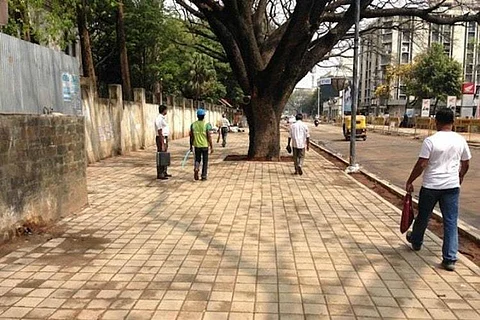

A total of 1,218 pedestrians have died in road accidents in Bengaluru over the past four years, which translates to almost one person every day on average. This is more than 40% of the total number of people who died in road accidents in the same period. Statistics maintained by the Bengaluru City Traffic Police (BTP) show that over the last four years, while the number of casualties in road accidents has gradually decreased, the percentage of pedestrian deaths has remained around 40-45%.
The number of pedestrian deaths in Bengaluru for 2015, 2016, 2017 and 2018 were 338, 320, 284 and 276 respectively. The corresponding figures for injuries to pedestrians in these years were 1254, 1292, 1346 and 1217.
Experts attribute the drop in the number of pedestrian deaths, along with all form of road fatalities in Bengaluru, to the drastic reduction of average vehicular speeds due to increased congestion on the roads.
Read: A bright side to Bengaluru’s traffic: Fewer road accidents this year
Bad infrastructure, more deaths
The data also points to another trend. Places with apparently better civic infrastructure had lesser accident casualties including pedestrian deaths, while places like the Outer Ring Road with comparatively poorer facilities witnessed more frequent incidents.
For example, the highest number of deaths due to road accidents (not only pedestrians) in 2018, was in Yelahanka, the northern fringe of the city, with 48 deaths followed by KR Puram in the eastern fringe with 43 deaths. The same was true for 2017 and 2016 as well, with the two areas faring worst in this regard.
It may be noted that the figures for injuries are recorded by the Traffic Police department only when a motor vehicle is involved. There is no record of injuries due to bad footpaths and roads alone.
While the BTP does not keep station-wise data of pedestrian deaths, analysis by the Footpath Initiative— an organisation advocating better pedestrian facilities, shows a similar pattern in 2017.
The study showed that the highest number of pedestrian deaths was recorded in KR Puram, Banaswadi, Byatarayanapura, Yeshwanthpur, Madiwala, Peenya, Electronic City and Yelahanka. With 25 deaths in just one year, KR Puram alone contributed to 9% of total pedestrian deaths.
Anusha Chitturi, member of The Footpath Initiative, said, “Crashes are evidently lesser in the Central Business District, where most areas have wide footpaths and safe pedestrian crossings and such infrastructure safeguards the pedestrians from motorists.”
She added, “This is not the case in the peripheral areas which have wide ring roads without basic infrastructure such as footpaths and crossings. Vehicles also travel at very high speeds. All of these create conditions for high-severity crashes involving pedestrians in these areas.”
Need for skywalks, raised pedestrian crossings
The lack of skywalks and raised pedestrian crossing in areas like the Outer Ring Road is another reason that puts life of pedestrians at risk. For instance, until October 2018, the entire stretch of five kilometres between Marathahalli Junction and Ecospace Bellandur did not have any skywalks.
The skywalk that eventually came up too was sponsored by corporates and not by the BBMP. The only other skywalk that has been built near Columbia Asia Hospital was a result of large scale protests following the death of two pedestrians in two weeks, in a public-private partnership (PPP) model.
Five more skywalks are planned to be built on this stretch but residents say work is yet to begin.
Policy and budget
Ashish Verma, an expert on sustainable transportation at the Indian Institute of Science, Bengaluru blames the existing system of policy, planning and design for the present situation.
“These days, there is more and more focus on making commute faster, so we hear talks of grade separators, elevated corridors and flyovers. There is scant provision and focus for pedestrian facilities and this certainly leads to situations where walkers are forced to move in risky conditions, leaving them vulnerable to road fatalities. When a flyover is built with crores of rupees, there is no space for walkers nor is there any provision made for those on foot below the flyover. On the other side, pedestrian facilities itself are pathetic. At present, walking on footpaths is dangerous and akin to walking on a landmine. The only difference is instead of being blown up, you will get caved in,” he said.
Also read: Video: Bengaluru’s footpaths are so bad, you have to thakadhimithaaaaaa!
Pavement or death trap? Bengaluru man grievously injured due to broken footpath
He added, “Also many times, if the footpaths are fit for walking, they are encroached upon for parking or shoppers and the like drop construction waste on them. So there is never effective width ensured for walkers. Next is the absence of safe crossing facilities, whether it is signalised junctions or not. Even in signalised junctions, pedestrians are given time just for lip service, sometimes the time given is not enough to cross even half the road. In most situations, traffic police are also under pressure to clear the traffic. This inconvenience leads to more and more people switching to personal motorised transport. It’s a vicious cycle that we are stuck in.”
At present, for a city of 1.2 crore people, Bengaluru has 78.5 lakh registered vehicles, meaning an average of 65 vehicles for every 100 persons. This number is without counting the vehicles, which are registered outside the city.
A total of 1,697 vehicles were added to the city’s roads daily on average, given there was an accretion of 6,19,745 vehicles to the city’s roads between November 2017 and November 2018.
Sapna Karim, Head of Civic Participation of Janaagraha, which has analysed budgetary allocations of the BBMP, said, “It is true that the allocation for pedestrian infrastructure is not very high but as a caveat, many of the road projects that are tendered might also include works related to footpath. So it is very difficult to know what exactly is spent for that purpose alone."